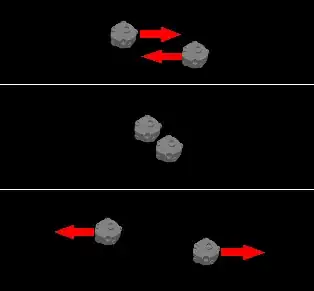For a 2D planar simulation with zero friction do the following
Definitions
- Each body has 3 degrees of freedom. These are $(x_1,y_1,\theta_1)$ and $(x_2,y_2,\theta_2)$ defined at the center of mass.
- Each body has mass and mass moment of inertia. These are $m_1$, $m_2$ and $Iz_1$, $Iz_2$.
- The contact is at point A with coordinates $(x_A,y_A)$ and with normal direction from the angle $\psi$ (measured CCW from +x).
- The coefficient of restitution is $\epsilon$
Representation
- The velocity of each body before the impact is defined with a 3×1 vector (in planar screw coordinates at the origin) $$\begin{aligned} v_1 &= \begin{pmatrix} \dot{x}_1 + \dot{\theta}_1 y_1 \\ \dot{y}_1 - \dot{\theta}_1 x_1 \\ \dot{\theta}_1 \end{pmatrix} & v_2 &= \begin{pmatrix} \dot{x}_2 + \dot{\theta}_2 y_2 \\ \dot{y}_2 - \dot{\theta}_2 x_2 \\ \dot{\theta}_2 \end{pmatrix} \end{aligned} $$
The contact normal (force) direction is
$$ n = \begin{pmatrix} \cos \psi \\ \sin\psi \\ x_A \sin\psi - y_A \cos \psi \end{pmatrix}$$
Note that the velocity of body 1 on the contact point, along the contact normal is found by $n \cdot v_1 = n^\top v_1 = (\dot{x}_1+\dot{\theta}_1 (y_1-y_A))\cos\psi + (\dot{y}_1-\dot{\theta}_1 (x_1-x_A))\sin\psi$
The inverse inertia matrix for each body is
$$ \begin{aligned}I_{1}^{-1} & =\begin{vmatrix}\frac{1}{m_{1}}+\frac{y_{1}^{2}}{Iz_{1}} & -\frac{x_{1}y_{1}}{Iz_{1}} & \frac{y_{1}}{Iz_{1}}\\
-\frac{x_{1}y_{1}}{Iz_{1}} & \frac{1}{m_{1}}+\frac{x_{1}^{2}}{Iz_{1}} & -\frac{x_{1}}{Iz_{1}}\\
\frac{y_{1}}{Iz_{1}} & -\frac{x_{1}}{Iz_{1}} & \frac{1}{Iz_{1}}
\end{vmatrix} & I_{2}^{-1} & =\begin{vmatrix}\frac{1}{m_{2}}+\frac{y_{2}^{2}}{Iz_{2}} & -\frac{x_{2}y_{2}}{Iz_{2}} & \frac{y_{2}}{Iz_{2}}\\
-\frac{x_{2}y_{2}}{Iz_{2}} & \frac{1}{m_{2}}+\frac{x_{2}^{2}}{Iz_{2}} & -\frac{x_{2}}{Iz_{2}}\\
\frac{y_{2}}{Iz_{2}} & -\frac{x_{2}}{Iz_{2}} & \frac{1}{Iz_{2}}
\end{vmatrix}\end{aligned}
$$
Elastic Impact
The impact velocity (scalar) is $$v_{imp} = -n^\top (v_2-v_1)$$
The inverse effective mass (scalar) along the contact of each body is
$$\begin{aligned}\mu_{1}^{-1} & =n^{\top}I_{1}^{-1}n & \mu_{2}^{-1} & =n^{\top}I_{2}^{-1}n\end{aligned}
$$
The impulse acting on body 2 is $$\boxed{ J = \frac{(1+\epsilon)\;v_{imp}}{\mu_{1}^{-1}+\mu_{2}^{-1}} } $$
The impact $J$ acting along $n$ changes the motion of each body by
$$ \begin{aligned}\Delta v_{1} & =-I_1^{-1} n\,J & \Delta v_{2} & =I_2^{-1} n\,J\end{aligned}
$$
The changes in motion are transferred back to the center of mass (change in) velocities $\Delta \dot{x}_1$, $\Delta \dot{y}_1$ and change in spin $\Delta \dot{\theta}_1$ by solving the following definition
$$\begin{aligned} \Delta v_1 &= \begin{pmatrix} \Delta \dot{x}_1 + \Delta \dot{\theta}_1 y_1 \\ \Delta \dot{y}_1 - \Delta \dot{\theta}_1 x_1 \\ \Delta \dot{\theta}_1 \end{pmatrix} & \Delta v_2 &= \begin{pmatrix} \Delta \dot{x}_2 + \Delta \dot{\theta}_2 y_2 \\ \Delta \dot{y}_2 - \Delta \dot{\theta}_2 x_2 \\ \Delta \dot{\theta}_2 \end{pmatrix} \end{aligned}$$
Impact Step
- The final velocity at the center of mass is changed from the step values
$$\begin{aligned}\dot{x}_{1} & \leftarrow\dot{x}_{1}+\Delta\dot{x_{1}} & \dot{x}_{2} & \leftarrow\dot{x}_{2}+\Delta\dot{x_{2}}\\
\dot{y}_{1} & \leftarrow\dot{y}_{1}+\Delta\dot{y_{1}} & \dot{y}_{2} & \leftarrow\dot{y}_{2}+\Delta\dot{y_{2}}\\
\dot{\theta}_{1} & \leftarrow\dot{\theta}_{1}+\Delta\dot{\theta_{1}} & \dot{\theta}_{2} & \leftarrow\dot{\theta}_{2}+\Delta\dot{\theta_{2}}
\end{aligned} $$
